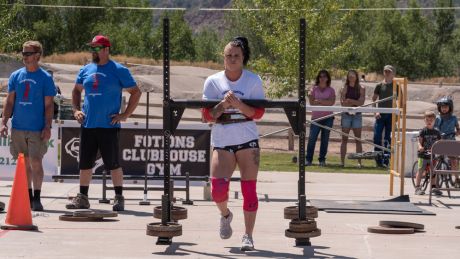The Farmer’s Walk Is The Epitome Of Training Efficiently
Why you should add the original loaded carry to your day

If your Christmas traditions involved settling down to watch burly men achieve incredible feats on The World’s Strongest Man, you’ll likely be familiar with the farmer’s walk, or the giant farmer’s walk as it’s known on the show. The hulking behemoths that compete for the title generally carry an absurd 160kg in each arm.
The current Guinness world record for the fastest farmer’s walk uses slightly more modest 150kg weights and is competed over a distance of 20m, with Laurence Shahlaei from the UK currently topping the charts with a time of 6.73 seconds. So far, so what has this got to do with you? Well…
“Loaded carries such as farmer’s walks are now receiving appropriate recognition within the wider strength training community, having previously been in the exclusive realm of the World’s Strongest Man contest,” says strength and conditioning coach Jack Lovett (spartanperformance.co.uk). “And it’s about time too, because these lifts are simple to perform and extremely effective at providing a multitude of benefits simultaneously.”
These benefits include developing a strong core brace, which ensures the spine remains neutral by protecting against both shear and compressive forces; enhanced proprioception (your sense of where your body parts are positioned), because you must move with the load while maintaining a braced core; increased willpower and focus, because loaded carries are tough to do; and, of course, muscle growth because of the extended period of muscular tension, especially in the upper back, forearms and legs.
“If you never perform any type of loaded carry then you are missing out on all the above benefits from a single exercise,” says Lovett. “They are the epitome of training efficiently. In terms of simple impact, [US strength coach] Dan John rates loaded carries as the number one ‘game changer’ for athletes. I couldn’t agree more, and they will work just as well for the non-athlete too who wants to increase strength and muscle mass.”
The farmer’s walk is the original loaded carry and the easiest to perform. You can use dumbbells, kettlebells, regular barbells, a trap deadlift bar or specific farmer’s walk handles. Here’s how to do it.
How To Do The Farmer’s Walk
Stand tall with weights held by your sides. Keep your shoulders tight and your back straight. Take short, quick steps as you walk a set distance, which will likely be limited by the size of your gym, unless you really are a farmer and have the luxury of a field.
Sign up for workout ideas, training advice, reviews of the latest gear and more.
It can be tricky to get the weight right, but given that you’re just holding it by your side, you can carry a hefty amount. Start off with some of the heavier dumbbells and kettlebells (20 to 30kg), and if that’s not enough of a burden, grab a small barbell and load it up. Some gyms will have special farmer’s walk barbells or handles you can strap onto the heavier disk weights.
Walking for a longer distance in one go or increasing the amount of walks will also ramp up the challenge.
See related
Farmer's Walk Variations

And if you still want a hypertrophy benefit from your strength work, try the Zercher carry, where you walk with a barbell in the crook of your arms. To perform a Zercher carry, take a barbell out of a rack by positioning it in the crook of your arms. Brace your core before you lift and keep your torso upright throughout the move. If you need to put a pad on the bar to protect your arms, that’s fine. Walk either for a set distance or for time – 40 seconds will provide a good challenge.
Kettlebell Carries
If your gym doesn’t have standard farmer’s walk handles, kettlebells make for a more than handy replacement. They have shorter handles and, thanks to their shape and size, are much easier to keep stable. While this may not call upon as much core strength, it acts as an excellent precursor for progression. Kettlebells are also great for grip strength.
One-Arm Carry
A tricky test of core strength, the one-arm farmer’s walk is the natural progression from the standard two-arm version. In addition to the trap- and back-building benefits garnered from the standard carry, this variant recruits much of the core abdominal fibres in order to stabilise the body. One-arm lifts are also a great way to iron out any muscular imbalances.
Inverted Kettlebell Carry
If your shoulders are feeling battered and bruised from a heavy benching session or too much time at a desk, then give the inverted kettlebell carry a try. Holding a single kettlebell in one arm upside down by its handle, brace your core and keep a neutral spine. This move activates the rotator cuff muscles like no other carry, and the rotator cuffs are crucial for shoulder mobility and range of motion.

Nick Harris-Fry is a journalist who has been covering health and fitness since 2015. Nick is an avid runner, covering 70-110km a week, which gives him ample opportunity to test a wide range of running shoes and running gear. He is also the chief tester for fitness trackers and running watches, treadmills and exercise bikes, and workout headphones.
